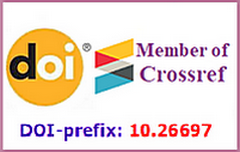Makelana P. 1, Kekwaletswe R. 2, Segooa M. A. 1
| 1 Tshwane University of Technology, South Africa |
| 2 University of Johannesburg, South Africa |
Abstract
Background and Aim of Study: To remain competitive in today’s digital society, Small and Medium Enterprises (SMEs) in the healthcare sector need to consider effective ways to improve their dynamic capabilities (DCs) using Software as a Service (SaaS). SaaS and DCs are current key issues in both academia and practice.
The aim of the study: to develop the conceptual model for the use of SaaS to improve the DCs of healthcare SMEs in South Africa.
Materials and Methods: The study employed Task-Technology Fit (TTF) and Fit Viability Model (FVM) as a lens to develop a model for the use of SaaS to improve the DCs of healthcare SMEs. To achieve the aim of the study, a deductive approach was followed. The study population was healthcare SMEs, in South Africa. The sampling frame was 384 randomly selected SMEs, in a self-administered survey.
Results: The study results show that customer service (β=0.125, p<0.05), sharing information (β=0.132, p<0.05), internet access (β=0.057, p<0.05), data security (β=0.022, p<0.05), top management support (β=0.427, p<0.05), competitive pressure (β=0.178, p<0.05), viability (β=0.325, p<0.05) and task-technology fit (β=0.032, p<0.05) are highly significant on the use of SaaS to improve the DCs of healthcare SMEs. While finance (β=0.235, p>0.05) and infrastructure (β=0.052, p>0.05) were found to be less significant.
Conclusions: The conceptual model was developed to identify and explain the factors influencing the use of SaaS to improve the DCs of healthcare enterprises. This model is based on TTF, FVM and external constructs (organisational and environmental characteristics) that are key to improving the DC of South African healthcare SMEs
Keywords
digitalisation, dynamic capabilities, task-technology fit, small and medium enterprises, healthcare sector, South Africa
References
Aceto, G., Persico, V., & Pescapé, A. (2020). Industry 4.0 and health: Internet of things, big data, and cloud computing for healthcare 4.0. Journal of Industrial Information Integration, 18, Article 100129. https://doi.org/10.1016/j.jii.2020.100129
Al-Mamary, Y. H. S. (2022). Understanding the use of learning management systems by undergraduate university students using the UTAUT model: Credible evidence from Saudi Arabia. International Journal of Information Management Data Insights, 2(2), Article 100092. https://doi.org/10.1016/j.jjimei.2022.100092
Alassafi, M. O. (2021). Success indicators for an efficient utilization of cloud computing in healthcare organizations: Saudi healthcare as case study. Computer Methods and Programs in Biomedicine, 212, Article 106466. https://doi.org/10.1016/j.cmpb.2021.106466
Balta, M., Valsecchi, R., Papadopoulos, T., & Bourne, D. J. (2021). Digitalization and co-creation of healthcare value: A case study in occupational health. Technological Forecasting and Social Change, 168, Article 120785. https://doi.org/10.1016/j.techfore.2021.120785
Bolosha, A., Sinyolo, S., & Ramoroka, K. H. (2022). Factors influencing innovation among small, micro and medium enterprises (SMMEs) in marginalized settings: Evidence from South Africa. Innovation and Development, 13(3), 583–601. https://doi.org/10.1080/2157930X.2022.2092681
Bularafa, B. A., & Adamu, U. G. (2021). Effect of Covid-19 pandemic on SME performance in Nigeria. Advanced International Journal of Business, Entrepreneurship and SMEs, 3(7), 75–92. https://doi.org/10.35631/aijbes.37007
Bvuma, S., & Marnewick, C. (2020). An information and communication technology adoption framework for small, medium and micro-enterprises operating in townships South Africa. Southern African Journal of Entrepreneurship and Small Business Management, 12(1), Article 318. https://doi.org/10.4102/sajesbm.v12i1.318
Creswell, J. W., & Creswell, J. D. (2018). Research design: Qualitative, quantitative, and mixed methods approaches. SAGE Publications, Inc. https://spada.uns.ac.id/pluginfile.php/510378/mod_resource/content/1/creswell.pdf
Deloitte UK’s Centre for Health Solution. (2020). Digital transformation: Shaping the future of European healthcare. Deloitte. https://www2.deloitte.com/content/dam/Deloitte/uk/Documents/life-sciences-health-care/deloitte-uk-shaping-the-future-of-european-healthcare.pdf
Drydakis, N. (2022). Artificial intelligence and reduced SMEs’ business risks. A dynamic capabilities analysis during the COVID-19 pandemic. Information Systems Frontiers, 24(4), 1223–1247. https://doi.org/10.1007/s10796-022-10249-6
Enesi, O. E., & Ibrahim, U. A. (2021). Effect of COVID-19 pandemic on the performance of small and medium business enterprises in Abuja-FCT, Nigeria. Open Journal of Business and Management, 09(05), 2261–2276. https://doi.org/10.4236/ojbm.2021.95122
Engelmann, A. (2024). A performative perspective on sensing, seizing, and transforming in small- and medium-sized enterprises. Entrepreneurship and Regional Development, 36(5–6), 632–658. https://doi.org/10.1080/08985626.2023.2262430
Fahmi, K., Sihotang, M., Hadinegoro, R., Sulastri, E., Cahyono, Y., & Megah, S. I. (2022). Health Care SMEs Products Marketing Strategy: How the Role of Digital Marketing Technology through Social Media? Universal Journal of Science and Technology, 1(1), 16–22. https://ujost.org/index.php/journal/article/view/55
Ganiga, R., Pai, R. M., Pai, M., & Sinha, R. K. (2018). Private cloud solution for securing and managing patient data in rural healthcare system. Procedia Computer Science, 135, 688–699. https://doi.org/10.1016/j.procs.2018.08.217
Hair, J. F., Ringle, C. M., Gudergan, S. P., Fischer, A., Nitzl, C., & Menictas, C. (2019). Partial least squares structural equation modeling-based discrete choice modeling: An illustration in modeling retailer choice. Business Research, 12(1), 115–142. https://doi.org/10.1007/s40685-018-0072-4
Hall, J. R., Savas-Hall, S., & Shaw, E. H. (2023). A deductive approach to a systematic review of entrepreneurship literature. Management Review Quarterly, 73, 987–1016. https://doi.org/10.1007/s11301-022-00266-9
Hasan, M. N. (2016). Positivism: To what extent does it aid our understanding of the contemporary social world? Quality and Quantity, 50(1), 317–325. https://doi.org/10.1007/s11135-014-0150-4
Johnston, A.O., Pretorius, A., & Lavhengwa, T. (2023). The effect of internet threat on small businesses in South Africa. In R. Silhavy, & P. Silhavy (Eds.), Networks and Systems in Cybernetics. Proceedings of 12th Computer Science On-line Conference 2023: Vol. 723. Lecture Notes in Networks and Systems, (pp. 149–168). Springer. https://doi.org/10.1007/978-3-031-35317-8_14
Khaki, A. A., & Khan, T. A. (2023). Social media marketing and its influence on the performance of micro, small, and medium-sized tourism enterprises: Mediation of innovation capabilities. Journal of Global Marketing, 37(1), 1–23. https://doi.org/10.1080/08911762.2023.2250998
Khan, O., Daddi, T., & Iraldo, F. (2021). Sensing, seizing, and reconfiguring: Key capabilities and organizational routines for circular economy implementation. Journal of Cleaner Production, 287, Article 125565. https://doi.org/10.1016/j.jclepro.2020.125565
Khurana, I., Dutta, D. K., & Singh Ghura, A. (2022). SMEs and digital transformation during a crisis: The emergence of resilience as a second-order dynamic capability in an entrepreneurial ecosystem. Journal of Business Research, 150, 623–641. https://doi.org/10.1016/j.jbusres.2022.06.048
Kikawa, C.R., Kiconco, C., & Kalema, B. (2022). Social Media marketing for small and medium enterprise performance in Uganda: A structural equation model. Sustainability, 14(21), Article 14391. https://doi.org/10.3390/su142114391
Krejcie, R. V., & Morgan, D. W. (1970). Determining sample size for research activities. Educational and Psychological Measurement, 30(3), 607–610. https://doi.org/10.1177/001316447003000308
Liang, T. P., Kohli, R., Huang, H. C., & Li, Z. L. (2021). What drives the adoption of the blockchain technology? A fit-viability perspective. Journal of Management Information Systems, 38(2), 314–337. https://doi.org/10.1080/07421222.2021.1912915
Loukis, E., Janssen, M., & Mintchev, I. (2019). Determinants of software-as-a-service benefits and impact on firm performance. Decision Support Systems, 117, 38–47. https://doi.org/10.1016/j.dss.2018.12.005
Majengo, R., & Mbise, M. (2022). Determinants of software-as-a-service adoption by small and medium enterprises in Tanzania. The African Journal of Information Systems, 14(1), Article 2. https://digitalcommons.kennesaw.edu/ajis/vol14/iss1/2
Maroufkhani, P., Tseng, M. L., Iranmanesh, M., Ismail, W. K. W., & Khalid, H. (2020). Big data analytics adoption: Determinants and performances among small to medium-sized enterprises. International Journal of Information Management, 54, Article 102190. https://doi.org/10.1016/j.ijinfomgt.2020.102190
Meri, A., Hasan, M.K., Danaee, M., Jaber, M., Jarrar, M., Safei, N., Dauwed, M., Abd, S. K., Al-bsheish, M. (2019). Corrigendum to “Modelling the utilization of cloud health information systems in the Iraqi public healthcare sector”. Telematics and Informatics, 39, 101. https://doi.org/10.1016/j.tele.2019.03.004
Mokwena, S., & Hlebela, C. (2018). Factors affecting the adoption of software as a service in South African small medium enterprises. In M. N. Ochara, & C. Moro (Eds.), Proceedings of the 2018 Open Innovations Conference (pp. 134–139). IEEE. https://doi.org/10.1109/OI.2018.8535714
Moretti, N., Mukherjee, A., Chan, Y.-C., Yilmaz, G., Merino, J., Sasidharan, M., Rosun, Z., Carr, C., McFarlane, D., & Parlikad, A. K. (2023). Low-cost digitalisation opportunities in healthcare: A histopathology department case study. Proceedings of the Low-Cost Digital Solutions for Industrial Automation Conference (pp. 62–68). IEEE. https://doi.org/10.1049/icp.2023.1735
Moyo, M., & Loock, M. (2021). Conceptualising a cloud business intelligence security evaluation framework for small and medium enterprises in small towns of the Limpopo Province, South Africa. Information, 12(3), Article 128. https://doi.org/10.3390/info12030128
Mubarakali, A., Ashwin, M., Mavaluru, D., & Kumar, A. D. (2020). Design an attribute based health record protection algorithm for healthcare services in cloud environment. Multimedia Tools and Applications, 79(5–6), 3943–3956. https://doi.org/10.1007/s11042-019-7494-7
Nassoura, A. B. (2020). Critical success factors for adoption of cloud computing in Jordanian healthcare organizations. International Journal of Scientific and Technology Research, 9(4), 2798–2803. https://www.ijstr.org/final-print/apr2020/Critical-Success-Factors-For-Adoption-Of-Cloud-Computing-In-Jordanian-Healthcare-Organizations.pdf
Nicolau, C., Nichifor, E., Munteanu, D., & Bărbulescu, O. (2022). Decoding business potential for digital sustainable entrepreneurship: What Romanian entrepreneurs think and do for the future. Sustainability, 14(20), Article 13636. https://doi.org/10.3390/su142013636
Pietronudo, M. C., Caporuscio, A., Ragione, G. La, & Risitano, M. (2022). New emerging capabilities for managing data-driven innovation in healthcare : the role of digital platforms. European Journal of Innovation Management, 25(6), 867–891. https://doi.org/10.1108/EJIM-07-2021-0327
Pypenko, I. S. (2019). Digital product: The essence of the concept and scopes. International Journal of Education and Science, 2(4), 56. https://doi.org/10.26697/ijes.2019.4.41
Preko, M., & Boateng, R. (2020). Assessing healthcare digitalisation in Ghana: A critical realist’s approach. Health Policy and Technology, 9(2), 255–262. https://doi.org/10.1016/j.hlpt.2020.03.006
Raimo, N., De Turi, I., Albergo, F & Vitolla, F. (2023). The drivers of the digital transformation in the healthcare industry: An empirical analysis in Italian hospitals. Technovation, 121, Article 102558. https://doi.org/10.1016/j.technovation.2022.102558
Salah, O. H., & Ayyash, M. M. (2023). E-commerce adoption by SMEs and its effect on marketing performance: An extended of TOE framework with AI integration, innovation culture, and customer tech-savviness. Journal of Open Innovation: Technology, Market, and Complexity, 10(1), Article 100183. https://doi.org/10.1016/j.joitmc.2023.100183
Salisu, I., Bin Mohd Sappri, M., & Bin Omar, M. F. (2021). The adoption of business intelligence systems in small and medium enterprises in the healthcare sector: A systematic literature review. Cogent Business and Management, 8(1), Article 1935663. https://doi.org/10.1080/23311975.2021.1935663
SEDA. (2021). SMME quarterly update. 1st quarter 2021. https://www.seda.org.za/Publications/Publications/SMME%20Quarterly%202021%20Q1%20September.pdf
Spanò, R., Massaro, M., & Iacuzzi, S. (2023). Blockchain for value creation in the healthcare sector. Technovation, 120, Article 102440. https://doi.org/10.1016/j.technovation.2021.102440
Statista. (2023). Software as a Service – South Africa. https://www.statista.com/outlook/tmo/public-cloud/software-as-a-service/south-africa
Steenkamp, J. B. E. M., & Maydeu-Olivares, A. (2023). Unrestricted factor analysis: A powerful alternative to confirmatory factor analysis. Journal of the Academy of Marketing Science, 51(1), 86–113. https://doi.org/10.1007/s11747-022-00888-1
Suhendi, C., Nugroho, M., Yahya, H. B., & Zahari, A. S. M. (2020). Dynamic capabilities for SME’s: Ready to change and cloud service role toward digital business. Proceedings of the 17 International Symposium on Management. Advances in Economics, Business and Management Research, 115, 129–133. https://doi.org/10.2991/aebmr.k.200127.026
Trawnih, A., Yaseen, H., Al-Adwan, A. S., Alsoud, A. R., & Jaber, O. (2021). Factors influencing social media adoption among SMEs during Covid-19 crisis. Journal of Management Information and Decision Sciences, 24(6), 1–18. https://www.abacademies.org/articles/factors-influencing-social-media-adoption-among-smes-during-covid19-crisis-11205.html
Wang, S. L., Lin, H. I., Wang, S. L., & Lin, H. I. (2019). Integrating TTF and IDT to evaluate user intention of big data analytics in mobile cloud healthcare system. Behaviour & Information Technology, 38(9), 974–985. https://doi.org/10.1080/0144929X.2019.1626486
Warner, K. S. R., & Wäger, M. (2019). Building dynamic capabilities for digital transformation: An ongoing process of strategic renewal. Long Range Planning, 52(3), 326–349. https://doi.org/10.1016/j.lrp.2018.12.001
Weaven, S., Quach, S., Thaichon, P., Frazer, L., Billot, K., & Grace, D. (2021). Surviving an economic downturn: Dynamic capabilities of SMEs. Journal of Business Research, 128, 109–123. https://doi.org/10.1016/j.jbusres.2021.02.009
Yusoff, A. S. M., Peng, F. S., Razak, F. Z., & Mustafa, W. (2020). Discriminant validity assessment of religious teacher acceptance: The use of HTMT criterion. Journal of Physics: Conference Series, 1529(4), Article 042045. https://doi.org/10.1088/1742-6596/1529/4/042045
Zimmermannova, J., Pavlik, L., & Chytilova, E. (2022). Digitalisation in hospitals in COVID-19 times – A case study of the Czech Republic. Economies, 10(3), Article 68. https://doi.org/10.3390/economies10030068
Makelana Penuel (Corresponding Author) – https://orcid.org/0000-0003-0986-1117;
Kekwaletswe Ray – https://orcid.org/0000-0002-3455-3127; Professor, School of Management, University of Johannesburg, Johannesburg, South Africa.
Segooa Mmatshuene Anna – https://orcid.org/0000-0002-4190-8256; Doctor of Computing, Lecturer, Department of Informatics, Tshwane University of Technology, Pretoria, South Africa.
| |
APA
Makelana, P., Kekwaletswe, R., & Segooa, M. A. (2024). Conceptualizing a model for the use of software as a service to improve the dynamic capabilities of small and medium enterprises in healthcare sector.. International Journal of Science Annals, 7(1), 51–59. https://doi.org/10.26697/ijsa.2024.1.5
Harvard
Makelana, P., Kekwaletswe, R., & Segooa, M. A. 2024. "Conceptualizing a model for the use of software as a service to improve the dynamic capabilities of small and medium enterprises in healthcare sector.". International Journal of Science Annals, [online] 7(1), pp. 51–59. viewed 30 June 2024, https://culturehealth.org/ijsa_archive/ijsa.2024.1.5.pdfVancouver
Makelana P., Kekwaletswe R., & Segooa M. A. Conceptualizing a model for the use of software as a service to improve the dynamic capabilities of small and medium enterprises in healthcare sector.. International Journal of Science Annals [Internet]. 2024 [cited 30 June 2024]; 7(1): 51–59. Available from: https://culturehealth.org/ijsa_archive/ijsa.2024.1.5.pdf https://doi.org/10.26697/ijsa.2024.1.5












